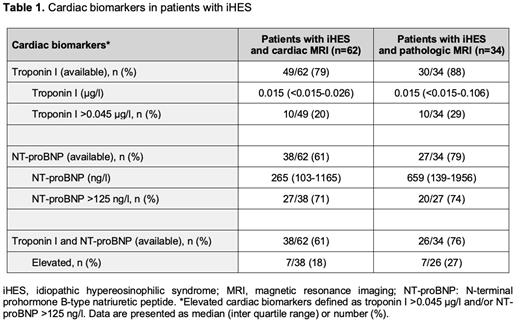Introduction: Diagnostic criteria of idiopathic hypereosinophilic syndrome (iHES) comprise persisting reactive/non-clonal eosinophilia ≥1.5 G/l and associated organ infiltration/dysfunction. The pattern and extent of organ involvement is most relevant for symptoms, quality of life, complications, response to treatment and prognosis. Of note, the potentially life-threatening cardiac involvement (CI) is frequently underrecognized.
Patients and Methods: Based on the ´German Registry on Disorders of Eosinophils and Mast Cells (GREM)', we sought to investigate CI in 62 patients (pts) with iHES and predominantly multifocal organ involvement (sinus [n=26], lungs [n=36, including asthma, n=23], abdominal organs [n=15], skin [n=15] and lymph nodes [n=9]) by cardiac magnetic resonance imaging (MRI, 62/62 pts), echocardiography (30/62 pts), myocardial biopsy (10/62 pts) and the cardiac biomarkers troponin I (TNI, 49/62 pts) and N-terminal prohormone B-type natriuretic peptide (NT-proBNP, 38/62 pts). Clonal eosinophilia, e.g. FIP1L1::PDGFRA, alternative tyrosine kinase fusion genes and point mutations, e.g. KIT D816V, was excluded by the combination of cytogenetic/molecular analyses, bone marrow histology and immunohistochemistry. Myeloid peroxidase (MPO)-ANCA antibodies as characteristic marker of eosinophilic granulomatosis with polyangiitis (EGPA) were absent in all 62/62 (100%) pts and no evaluable patient had histologic evidence of vasculitis.
Results: Cardiac MRI was pathologic in 34/62 (55%) pts with overlapping presence of late gadolinium enhancement (LGE, 31/34, 91%), pericardial effusion (11/34, 32%), involvement of heart valves/conduction system (9/34, 26%), impaired left-ventricular ejection fraction (LVEF <50%, 9/34, 26%) and presence of intracavitary thrombus (6/34, 18%). Concomitant echocardiography revealed pathological findings only in 10/24 (42%) pts with a pathologic MRI. Myocardial biopsy unveiled fibrosis (4/10, 40%) or eosinophilic infiltration (2/10, 20%) but was also non-informative (4/10, 40%). CI was rather associated with involvement of lungs (24/34, 71%) and sinus (23/34, 68%) than of abdominal organs (8/34, 24%) and skin (5/34, 15%). The combination of CI and asthma, potentially suggestive of ANCA-negative EGPA, was observed in 16/34 (47%) pts, but an indistinguishable pattern of multifocal organ involvement was also present in 18/34 (53%) pts with CI and absence of asthma. All 10/49 (20%) pts with an elevated vs. 0/49 (0%) pts with a normal troponin I (<0.045µg/l) and 20/38 (53%) pts with an elevated vs. 7/38 (18%) pts with a normal NT-proBNP (<125ng/l) revealed a pathologic cardiac MRI (Table). During a median follow-up of 108 months (range 3-470), the occurrence of cardiac events (n=15; death, n=3; cerebral embolism, n=4; worsening of LVEF, n=2; arrhythmias, n=2; valve surgery, n=2; pericardial effusion, n=1; coronary artery aneurysm, n=1) was strongly associated with a pathologic cardiac MRI in 15/15 (100%) pts (prior to MRI, n=6; after MRI, n=9) and an elevated troponin I and/or elevated NT-proBNP in 14/15 (93%) or 12/15 (80%) pts, respectively. During a median follow-up of 7.6 years (range 0.3-29.2), glucocorticoid-based immunosuppressive treatment resulted in improved MRI findings in 9/20 (45%) pts (improved LGE, n=7; regression of thrombus, n=1; improved LVEF, n=1) and a median NT-proBNP decrease of 48%. In pts with a pathologic MRI and elevated biomarkers, 9/13 (69%) and 5/19 (26%) pts, respectively, had a normalization of troponin I or NT-proBNP.
Conclusions: In pts with iHES, i) the incidence of CI is high, particularly in pts with multifocal organ involvement, ii) it is questionable whether absence or presence of asthma in pts with multiple organ involvement is qualified for the challenging differentiation between iHES and ANCA-negative EGPA, iii) CI should be assessed by troponin I/NT-proBNP and cardiac MRI as they are superior to echocardiography, iv) the combination of elevated troponin I and to a lesser extent also elevated NT-proBNP with a pathologic cardiac MRI is associated with retrospective and subsequent, potentially life threatening cardiac events, and v) cardiac biomarkers and cardiac MRI are useful for monitoring response to treatment.
Disclosures
Reiter:AOP Orphan Pharmaceuticals: Consultancy, Honoraria, Membership on an entity's Board of Directors or advisory committees, Research Funding; GSK: Consultancy, Honoraria, Membership on an entity's Board of Directors or advisory committees, Research Funding; Incyte Corporation: Consultancy, Honoraria, Membership on an entity's Board of Directors or advisory committees, Research Funding; Blueprint Medicines Corporation: Consultancy, Honoraria, Membership on an entity's Board of Directors or advisory committees, Research Funding; BMS: Consultancy, Honoraria, Membership on an entity's Board of Directors or advisory committees, Research Funding; AbbVie: Consultancy, Honoraria, Membership on an entity's Board of Directors or advisory committees, Research Funding; Novartis: Consultancy, Honoraria, Membership on an entity's Board of Directors or advisory committees, Research Funding. Schwaab:GlaxoSmithKline: Consultancy, Honoraria, Research Funding; Blueprint Medicines: Consultancy, Honoraria; Novartis Pharma: Honoraria.


This feature is available to Subscribers Only
Sign In or Create an Account Close Modal